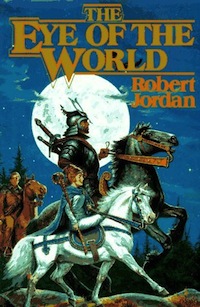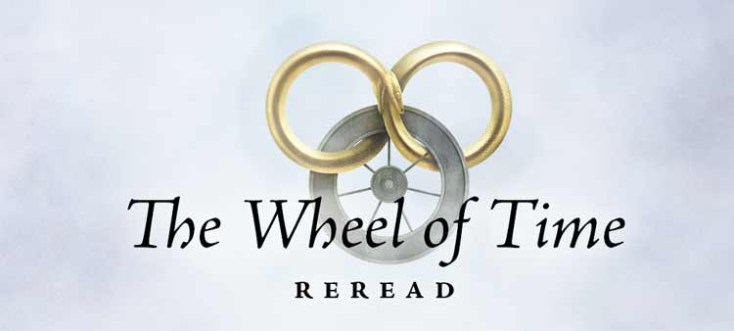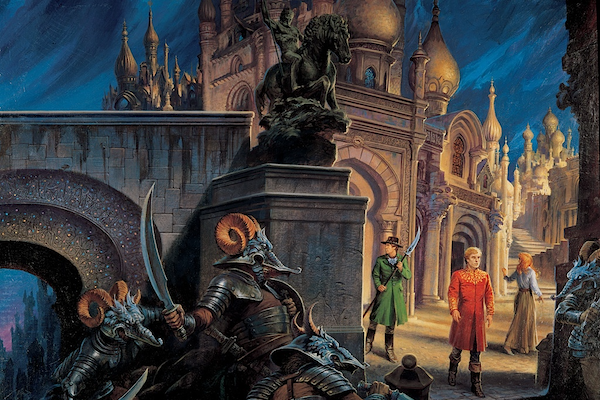Look on my Wheel of Time Reread Redux, ye mighty, and despair! Or at least feel mildly bad about yourselves! Today’s Redux post will cover Chapter 29 and 30 of The Eye of the World, originally reread in this post.
All original posts are listed in The Wheel of Time Reread Index here, and all Redux posts will also be archived there as well. (The Wheel of Time Master Index, as always, is here, which has links to news, reviews, interviews, and all manner of information about the Wheel of Time in general on Tor.com.)
The Wheel of Time reread is also now available as an ebook series, except for the portion covering A Memory of Light, which should become available soon.
All Reread Redux posts will contain spoilers for the entire Wheel of Time series, so if you haven’t read, read at your own risk.
And now, the post!
 Chapter 29: Eyes Without Pity
Chapter 29: Eyes Without Pity
Redux Commentary
I don’t know why I keep forgetting about this chapter, because as I said originally, it’s really well done—tension galore. The idea of being hunted by a giant flock of ravens is such a scary one, in fact, that I’m sort of surprised it never got used again in the series (at least as far as I can recall).
Jordan’s use of ravens in WOT is an interesting contrast to how he uses wolves. Even though both wolves and ravens have mixed and often conflicting reputations in real-world myth and culture, in WOT wolves are presented to be universally Good Guys, while ravens are pretty much exclusively of the Shadow; Mat’s Odin-influenced association with them seems to be the sole exception.
It’s even more interesting when you consider that wolves and ravens are very frequently linked in nature. Symbiotic relationships between mammals are rare, but the relationship of wolves and ravens is one of them—to the point where the Inuit called ravens “wolf-birds.” Ravens follow wolf packs and steal bits of their kills, but they have also been known to lead wolves to prey too large for the ravens to handle themselves, and there is evidence that they serve as eyes and ears for wolves, to alert them of danger while the wolves are preoccupied with their kills. And there are a number of documented instances of ravens and wolves playing together.
This link between wolves and ravens is reflected in many mythologies as well. The most famous of which is probably that of our old pal Odin, whose association with his ravens Huginn and Muninn is well known (and referenced in WOT via Mat, as I mentioned earlier), but he was also frequently depicted as being flanked by his wolves, Geri and Freki, as well as his ravens. The connection between the two animals shows up in a bunch of other places as well, especially in the legends of the Native American tribes of the Pacific Northwest.
So the raven gets kind of unfairly maligned in WOT, really, at least compared to the wolves, but it’s not like that unsavory reputation isn’t backed up by plenty of cultural references, especially the more recent depictions of it in Western culture, like Edgar Allen Poe, Disney films, or even Alfred Hitchcock. (The birds in The Birds may not have been exclusively crows or ravens, but those are the ones I remember most vividly, for sure.) So it seems that Jordan decided to go with the more recent cultural associations of ravens as solely Evil, as opposed to the older myths, which were much more ambiguous on the subject as a general rule. Ravens have nearly always been associated with death, true, but death is not always or even often considered to be a bad thing, after all. And ravens were just as often considered to be guides and protectors of the dead as anything else.
*shrug* But, you know. Big, night-colored, creepily intelligent carrion eaters that can stab your eyes out with their beaks are hella scary. And death is definitely a bad thing in the mythology of WOT, considering that the Big Bad of the series is also known as “Lord of the Grave”. So it might not be fair, but it does make a certain amount of sense.
“The One Power won’t work here; they can’t touch the True Source. Can’t even feel the Source, like it vanished. Makes them itch inside, that does. Gives them the shakes like a seven-day drunk. It’s safety.”
Never quite understood how the One Power could be excluded from a place when it’s supposed to be the thing that drives the Wheel of Time itself. It seems sort of like declaring there are going to be random spots where gravity doesn’t work, just because.
“Artur Paendrag Tanreall, Artur Hawkwing, the High King, united all the lands from the Great Blight to the Sea of Storms, from the Aryth Ocean to the Aiel Waste, and even some beyond the Waste. He even sent armies the other side of the Aryth Ocean. The stories say he ruled the whole world, but what he really did rule was enough for any man outside of a story. And he brought peace and justice to the land.”
I mentioned in the original commentary that Hawkwing’s story actually bears more resemblance to Alexander the Great than King Arthur, and that still sounds right to me, but his virulent hatred of Aes Sedai—i.e. magic users—that’s pure Arthuriana, if you ask me. Even though it seems more like the various magicians in Arthurian legend hated Arthur than the other way around. Still, with all the shenanigans gotten up to via magic in the legends, it’s not unreasonable to suppose that Arthur would have ended up less than thrilled with the entire concept at some point.
Funny how these emperor-kings are said to bring “peace and justice” to the land… by virtue of them killing anyone who disagreed with how they wanted to bring it. Stalin, just for example, brought great (if temporary) power and “peace” to his country; he just had to kill something like 20 million people to do it. I’m pretty sure it wasn’t worth the tradeoff, myself.
 Chapter 30: Children of Shadow
Chapter 30: Children of Shadow
Redux Commentary
Aw, Hopper. Still gets me both furious and choked up, every time.
At first it struck me as even more tragic than on the surface, since it seems like it would have been at least possible that Egwene and Perrin would have been able to bluff their way out of danger if Hopper hadn’t attacked. But then again, maybe it would not have been possible. I’m assuming that Perrin’s eyes haven’t turned gold yet at this point, since surely otherwise Bornhald would have mentioned them in his litany of “reasons” why Egwene and Perrin are “obviously” Darkfriends, but probably just being in the vicinity of all the wolf-related hoopla would have been “reason” enough for the Whitecloaks to decide to haul them along for “purification,” or whatever bullshit euphemism they use for their particular brand of theological terrorism.
Oh, by the way, I don’t like Whitecloaks. Have I mentioned that? I’ve probably mentioned that. You know, once or twice. Or a hundred times, whatever.
Doesn’t matter, because it is always worth mentioning again. Because that is how much I really, really, REALLY don’t like them. They are nearly everything I can’t stand about people, bundled up into one giant sanctimonious, sadistic, bigoted, narrow-minded, jingoistic, hypocritical, fanatical, and, and smelly bag of DICKS.
*grinds teeth*
“Dapple says they smell wrong. It’s… sort of the way a rabid dog smells wrong.”
But at least Jordan appears to agree with me. I don’t think there’s many more effective ways to express contempt for someone than to compare them to a mad dog. (Though I still think that’s an insult to the dog.)
“I hate this bloody thing,” he growled. “I don’t know what I’m doing with it, strutting around like some kind of fool. I couldn’t have done it, you know. When it was all pretend and maybe, I could swagger, and play as if I…” He sighed, his voice fading. “It’s different, now. I don’t ever want to use it again.”
“You’ll use it.”
Perrin raised the axe to throw it in the pool, but Elyas caught his wrist.
“You’ll use it, boy, and as long as you hate using it, you will use it more wisely than most men would. Wait. If ever you don’t hate it any longer, then will be the time to throw it as far as you can and run the other way.”
Perrin hefted the axe in his hands, still tempted to leave it in the pool. Easy for him to say wait. What if I wait and then can’t throw it away?
I forgot that Perrin’s axe dilemma was set up so early on, from basically the moment Perrin first contemplates doing something terrible yet possibly necessary with it (in this case, contemplating killing Egwene rather than letting her get torn apart by ravens).
I got pretty annoyed by this conflict later on, particularly during the Plot Line Of Doom in COT, but that doesn’t mean it isn’t a legitimate dilemma; it really is, and was representative of Perrin’s entire character arc. Because being able to make the choice to do (or not to do) terrible yet necessary things is the central conflict presented to any leader worth his or her salt. Or any warrior, for that matter, and Perrin has to become both. My issue with it was that it got drawn out too long.
That said, it’s a very nice bit of symmetry that literally throwing the axe away bookended both the beginning and the end of Perrin’s contentious relationship with the weapon.
And that’s all, folks! AT LEAST FOR NOW. Come back next Tuesday for more! Cheers!












